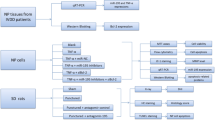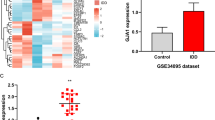Abstract
This study aimed to determine the effects of SKI on interleukin (IL)-1β-induced apoptosis of nucleus pulposus (NP) cells, intervertebral disc degeneration (IDD), and the Wnt signaling pathway. NP tissue specimens of different Pfirrmann grades (II–V) were collected from patients with different grades of IDD. Real-time polymerase chain reaction and western blotting were used to compare SKI mRNA and protein expression in NP tissues from patients. Using the IL-1β-induced IDD model, NP cells were infected with lentivirus-coated si-SKI to downregulate the expression of SKI and treated with LiCl to evaluate the involvement of the Wnt/β-catenin signaling pathway. Western blotting, immunofluorescence, and terminal deoxynucleotidyl transferase dUTP nick end labeling (TUNEL) staining were used to detect NP cell apoptosis, extracellular matrix (ECM) metabolism, and related protein expression changes in the Wnt/β-catenin signaling pathway. To investigate the role of SKI in vivo, a rat IDD model was established by needle puncture of the intervertebral disc. Rats were injected with lentivirus-coated si-SKI and evaluated by magnetic resonance imaging (MRI), and hematoxylin and eosin (HE) and safranin O staining. SKI expression positively correlated with the severity of human IDD. In the IL-1β-induced NP cell degeneration model, SKI expression increased significantly and reached a peak at 24 h. SKI knockdown protected against IL-1β-induced NP cell apoptosis and ECM degradation. LiCl treatment reversed the protective effects of si-SKI on NP cells. Furthermore, lentivirus-coated si-SKI injection partially reversed the NP tissue damage in the IDD model in vivo. SKI knockdown reduced NP cell apoptosis and ECM degradation by inhibiting the Wnt/β-catenin signaling pathway, ultimately protecting against IDD. Therefore, SKI may be an effective target for IDD treatment.











Similar content being viewed by others
References
Meucci RD, Fassa AG, Faria NM (2015) Prevalence of chronic low back pain: systematic review. Rev Saude Publica 49:1
James SL, Abate D, Abate KH et al (2018) Global, regional, and national incidence, prevalence, and years lived with disability for 354 diseases and injuries for 195 countries and territories, 1990–2017: a systematic analysis for the Global Burden of Disease Study 2017. Lancet 392(10159):1789–1858
James SL, Abate D, Abate KH et al (2015) Global, regional, and national incidence, prevalence, and years lived with disability for 301 acute and chronic diseases and injuries in 188 countries, 1990–2013: a systematic analysis for the Global Burden of Disease Study 2013. Lancet 386(9995):743–800
Takatalo J, Karppinen J, Niinimäki J et al (2011) Does lumbar disc degeneration on magnetic resonance imaging associate with low back symptom severity in young Finnish adults? Spine (Phila Pa 1976) 36(25):2180–2189
Roberts S, Evans H, Trivedi J et al (2006) Histology and pathology of the human intervertebral disc. J Bone Joint Surg Am 88(Suppl 2):10–14
Vergroesen PP, Kingma I, Emanuel KS et al (2015) Mechanics and biology in intervertebral disc degeneration: a vicious circle. Osteoarthr Cartil 23(7):1057–1070
Fujita N, Chiba K, Shapiro IM et al (2012) HIF-1α and HIF-2α degradation is differentially regulated in nucleus pulposus cells of the intervertebral disc. J Bone Miner Res 27(2):401–412
Xiang Q, Kang L, Wang J et al (2020) CircRNA-CIDN mitigated compression loading-induced damage in human nucleus pulposus cells via miR-34a-5p/SIRT1 axis. EBioMedicine 53:102679
He R, Wang Z, Cui M et al (2021) HIF1A Alleviates compression-induced apoptosis of nucleus pulposus derived stem cells via upregulating autophagy. Autophagy 17:1–23
Long J, Wang X, Du X et al (2019) JAG2/Notch2 inhibits intervertebral disc degeneration by modulating cell proliferation, apoptosis, and extracellular matrix. Arthritis Res Ther 21(1):213
Kadow T, Sowa G, Vo N et al (2015) Molecular basis of intervertebral disc degeneration and herniations: what are the important translational questions? Clin Orthop Relat Res 473(6):1903–1912
Chen J, Xie JJ, Jin MY et al (2018) Sirt6 overexpression suppresses senescence and apoptosis of nucleus pulposus cells by inducing autophagy in a model of intervertebral disc degeneration. Cell Death Dis 9(2):56
Zeng Y, Danielson KG, Albert TJ et al (2007) HIF-1 alpha is a regulator of galectin-3 expression in the intervertebral disc. J Bone Miner Res 22(12):1851–1861
Che H, Li J, Li Y et al (2020) p16 deficiency attenuates intervertebral disc degeneration by adjusting oxidative stress and nucleus pulposus cell cycle. Elife. https://doi.org/10.7554/eLife.52570
Bonnon C, Atanasoski S (2012) c-Ski in health and disease. Cell Tissue Res 347(1):51–64
Liao HY, Da CM, Wu ZL et al (2021) Ski: double roles in cancers. Clin Biochem 87:1–12
Landry N, Kavosh MS, Filomeno KL et al (2018) Ski drives an acute increase in MMP-9 gene expression and release in primary cardiac myofibroblasts. Physiol Rep 6(22):13897
Zhang C, Zhang Y, Zhu H et al (2018) MiR-34a/miR-93 target c-Ski to modulate the proliferaton of rat cardiac fibroblasts and extracellular matrix deposition in vivo and in vitro. Cell Signal 46:145–153
Xu H, Sun F, Li X et al (2018) Down-regulation of miR-23a inhibits high glucose-induced EMT and renal fibrogenesis by up-regulation of SnoN. Hum Cell 31(1):22–32
Fukasawa H, Yamamoto T, Togawa A et al (2006) Ubiquitin-dependent degradation of SnoN and Ski is increased in renal fibrosis induced by obstructive injury. Kidney Int 69(10):1733–1740
Zhao X, Wei Z, Li D et al (2019) Glucocorticoid enhanced the expression of ski in osteonecrosis of femoral head: the effect on adipogenesis of rabbit BMSCs. Calcif Tissue Int 105(5):506–517
Kim KO, Sampson ER, Maynard RD et al (2012) Ski inhibits TGF-β/phospho-Smad3 signaling and accelerates hypertrophic differentiation in chondrocytes. J Cell Biochem 113(6):2156–2166
Mohanty S, Pinelli R, Pricop P et al (2019) Chondrocyte-like nested cells in the aged intervertebral disc are late-stage nucleus pulposus cells. Aging Cell 18(5):e13006
Wu Z, Xie Q, Liu T et al (2021) Role of the Wnt pathway in the formation, development, and degeneration of intervertebral discs. Pathology 220:153366
Zhan S, Wang K, Song Y et al (2019) Long non-coding RNA HOTAIR modulates intervertebral disc degenerative changes via Wnt/β-catenin pathway. Arthritis Res Ther 21(1):201
Chen D, Xu W, Bales E et al (2003) SKI activates Wnt/beta-catenin signaling in human melanoma. Cancer Res 63(20):6626–6634
Pfirrmann CW, Metzdorf A, Zanetti M et al (2001) Magnetic resonance classification of lumbar intervertebral disc degeneration. Spine (Phila Pa 1976) 26(17):1873–1878
Urrutia J, Besa P, Campos M et al (2016) The Pfirrmann classification of lumbar intervertebral disc degeneration: an independent inter- and intra-observer agreement assessment. Eur Spine J 25(9):2728–2733
Han B, Zhu K, Li FC et al (2008) A simple disc degeneration model induced by percutaneous needle puncture in the rat tail. Spine (Phila Pa 1976) 33(18):1925–1934
Liu Y, Lin J, Wu X et al (2019) Aspirin-mediated attenuation of intervertebral disc degeneration by ameliorating reactive oxygen species in vivo and in vitro. Oxid Med Cell Longev 2019:7189854
Wang Y, Che M, Xin J et al (2020) The role of IL-1β and TNF-α in intervertebral disc degeneration. Biomed Pharmacother 131:110660
Rousseau MA, Ulrich JA, Bass EC et al (2007) Stab incision for inducing intervertebral disc degeneration in the rat. Spine (Phila Pa 1976) 32(1):17–24
Zhao CQ, Wang LM, Jiang LS et al (2007) The cell biology of intervertebral disc aging and degeneration. Ageing Res Rev 6(3):247–261
Dowdell J, Erwin M, Choma T et al (2017) Intervertebral disk degeneration and repair. Neurosurgery 80(3S):S46–S54
Li Z, Shao Z, Chen S et al (2020) TIGAR impedes compression-induced intervertebral disc degeneration by suppressing nucleus pulposus cell apoptosis and autophagy. J Cell Physiol 235(2):1780–1794
Lin J, Chen J, Zhang Z et al (2019) Luteoloside inhibits IL-1β-induced apoptosis and catabolism in nucleus pulposus cells and ameliorates intervertebral disk degeneration. Front Pharmacol 10:868
Xi Y, Ma J, Chen Y (2020) PTEN promotes intervertebral disc degeneration by regulating nucleus pulposus cell behaviors. Cell Biol Int 44(2):583–592
Rashidian J, Le Scolan E, Ji X et al (2015) Ski regulates Hippo and TAZ signaling to suppress breast cancer progression. Sci Signal 8(363):a14
Porter LF, Saptarshi N, Fang Y et al (2019) Whole-genome methylation profiling of the retinal pigment epithelium of individuals with age-related macular degeneration reveals differential methylation of the SKI, GTF2H4, and TNXB genes. Clin Epigenetics 11(1):6
Zeglinski MR, Davies JJ, Ghavami S et al (2016) Chronic expression of Ski induces apoptosis and represses autophagy in cardiac myofibroblasts. Biochim Biophys Acta 1863(6 Pt A):1261–1268
Kiyono K, Suzuki HI, Morishita Y et al (2009) c-Ski overexpression promotes tumor growth and angiogenesis through inhibition of transforming growth factor-beta signaling in diffuse-type gastric carcinoma. Cancer Sci 100(10):1809–1816
Fukuchi M, Nakajima M, Fukai Y et al (2004) Increased expression of c-Ski as a co-repressor in transforming growth factor-beta signaling correlates with progression of esophageal squamous cell carcinoma. Int J Cancer 108(6):818–824
Xie M, Wu X, Zhang J et al (2017) Ski regulates Smads and TAZ signaling to suppress lung cancer progression. Mol Carcinog 56(10):2178–2189
Wang P, Chen Z, Meng ZQ et al (2009) Dual role of Ski in pancreatic cancer cells: tumor-promoting versus metastasis-suppressive function. Carcinogenesis 30(9):1497–1506
Vo BT, Cody B, Cao Y et al (2012) Differential role of Sloan-Kettering Institute (Ski) protein in Nodal and transforming growth factor-beta (TGF-β)-induced Smad signaling in prostate cancer cells. Carcinogenesis 33(11):2054–2064
Kim H, Yamanouchi K, Nishihara M (2006) Expression of ski in the granulosa cells of atretic follicles in the rat ovary. J Reprod Dev 52(6):715–721
Ruiz-Fernández C, Francisco V, Pino J et al (2019) Molecular relationships among obesity, inflammation and intervertebral disc degeneration: are adipokines the common link? Int J Mol Sci 20(8):2030
Wang X, Zou M, Li J et al (2018) LncRNA H19 targets miR-22 to modulate H(2) O(2) -induced deregulation in nucleus pulposus cell senescence, proliferation, and ECM synthesis through Wnt signaling. J Cell Biochem 119(6):4990–5002
Chen J, Jia YS, Liu GZ et al (2017) Role of LncRNA TUG1 in intervertebral disc degeneration and nucleus pulposus cells via regulating Wnt/β-catenin signaling pathway. Biochem Biophys Res Commun 491(3):668–674
Ye S, Wang J, Yang S et al (2011) Specific inhibitory protein Dkk-1 blocking Wnt/β-catenin signaling pathway improve protectives effect on the extracellular matrix. J Huazhong Univ Sci Technol Med Sci 31(5):657
Xie H, Jing Y, Xia J et al (2016) Aquaporin 3 protects against lumbar intervertebral disc degeneration via the Wnt/β-catenin pathway. Int J Mol Med 37(3):859–864
Acknowledgements
We thank Editage (www.editage.cn) for English language editing.
Funding
This work was co-funded by the National Natural Science Foundation of China (No. 31960175).
Author information
Authors and Affiliations
Contributions
Conceptualization: Z-LW, H-HZ, and Y-JC; methodology: G-ZZ; software: Q-QX; writing—original draft preparation: Z-LW and G-ZZ; writing—review and editing: Y-JC, Q-QX, and H-HZ; visualization: Y-JC; supervision: H-HZ; All authors have read and agreed to the published version of the manuscript.
Corresponding author
Ethics declarations
Conflict of interest
The authors declare no conflict of interest.
Ethical approval
All experimental protocols were approved by the Ethics Committee of Lanzhou University Second Hospital, and written informed consent was obtained from each patient. The animal study was reviewed and approved by the Animal Use and Care Committee of Lanzhou University Second Hospital.
Additional information
Publisher's Note
Springer Nature remains neutral with regard to jurisdictional claims in published maps and institutional affiliations.
Supplementary Information
Below is the link to the electronic supplementary material.
Rights and permissions
About this article
Cite this article
Wu, Zl., Chen, Yj., Zhang, Gz. et al. SKI knockdown suppresses apoptosis and extracellular matrix degradation of nucleus pulposus cells via inhibition of the Wnt/β-catenin pathway and ameliorates disc degeneration. Apoptosis 27, 133–148 (2022). https://doi.org/10.1007/s10495-022-01707-2
Accepted:
Published:
Issue Date:
DOI: https://doi.org/10.1007/s10495-022-01707-2




